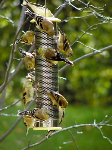-
sparrow’s at your finch bird feeder?
No, these aren’t Sparrows, but American Goldfinches in their drab winter plumage. A customer contacted me yesterday to see what could be done about the problematic House Sparrows in her yard. She said there were so many of them that the Goldfinches couldn’t even get near her finch bird feeder if they tried!
Although I’m not sure why, some folks admire and encourage House Sparrows… maybe it’s because that’s the only birds they can attract to their habitat? A non-native species (they should round them up and deport them back to Europe) along with Starlings, they wreak havoc on our native song birds. Bluebirds have no chance with sparrows around, and tree swallows too will lose out to sparrows for nesting cavities. Whole colonies of Purple Martins are chased away by sparrow invasion. I know there are no “mean birds” but sparrows instinct for survival is brutal with actual maiming and killing of nestlings and adults for use of the nest box.
So if you’re unlucky enough to have them in your yard… how do you get rid of them? First start by taking away the “welcome mat”. Try to remove the things that are attracting them, at least temporarily. Birdbaths should be emptied, and feeders taken down. I know this is a difficult task, but food in the wild is plentiful this fall (in most parts of the country) and it’s only for a short time, encouraging the sparrows to move on to other digs. Use quality birdseed too, it does make a difference. A mix that has a lot of corn or millet in it will also attract more “undesirable” birds.
Another option if you’re looking to attract Goldfinches only, is an upside down finch bird feeder. These are one of very few birds who will actually eat while perched upside down. And it’s not a bad thing… just being more selective about the beaked buddies you’re attracting to your yard!
-
traffic at thistle feeders may seem slow
Bird traffic in your yard may seem a bit slow right now, but resident songbirds will be back soon… and with a vengeance! Thistle Feeders and other bird feeders should be kept clean and full in anticipation of songbirds’ return. Jays, Chickadees, Woodpeckers, Tufted Titmice, Nuthatches, Warblers and even Bluebirds (in some areas) will over-winter if habitat is suitable. Traffic is slow because food in the wild is plentiful this fall and there’s an abundance of growth in certain parts of the country. Fruit and berry-producing trees and shrubs are filled with treats, and fields are grassy, with seeds, weeds, and coneflowers.
A welcoming habitat entails rolling out the red carpet for birds! A fresh water source is a must, especially when temps drop below freezing. Adequate roosting places in the form of birdhouses, roosting boxes, and mature trees and shrubs are necessary too. Adding a suet feeder entices many species as it provides the extra calories for energy needed to stay warm through freezing winter weather. Suet is convenient and easy to feed, leaves no waste or ground mess, and it’s enjoyed by many species. If you’ve never fed suet, we strongly advise giving it a try! You’ll find fun suet feeders at The Birdhouse Chick.com …and a free cake or plugs to get started right away!
Thistle, or nyjer is often referred to as “black gold” because of the cost. This non-germinating seed may be found more economically in bulk quantities at your local feed & seed store. Thistle feeders provide Goldfinches, House and Purple Finches a steady source of food through winter. And although their vibrant yellow plumage turns a drab olive-grey, Goldfinches will stick around for the duration.
This hand crafted thistle feeder is made in durable cedar and offers ten perching spots for birds to eat in peace. The groovy wave design is appealing to both humans and birds!
Welcome birds and help them thrive through harsh winters. The sights and sounds will help brighten up the dreariest days!
Take 10% off all thistle feeders through Oct. 31. Enter code MC10 @ checkout!
-
black hulls from your nyjer feeder
A friend of mine who’s new to birding recently received a nyjer feeder as a gift. Several times I’d asked if the finches were coming, but the answer was always no. Difficult for me to understand as our yard just forty miles away was inundated with Goldfinches.
The other day I asked again if there were any Goldfinches in the yard. This time my friend said no, none to be seen, but the seed was all over the ground. It only took a second to realize they were at the nyjer feeder if it was being emptied!
Thistle (or nyjer) is a non-germinating seed. It’s tiny grain-like shape is actually comprised of two parts: the seed itself, and the hull containing the seed. Goldfinches and others, will discard the hulls when feeding at nyjer feeders. These tiny black hulls tend to accumulate under the feeder as no other wildlife finds them suitable to the palette. For bird’s health, and aesthetics, it’s best to scoop up the hulls periodically as they become moldy and create a messy feeding area where fungus and bacteria could be easily spread.
So when my friend said “the seed’s all over the ground”… I knew right away the Goldfinches had discovered the new feeder. Maybe they just need to hone in on the bird watching skills?



